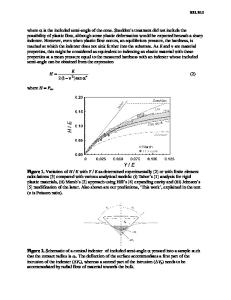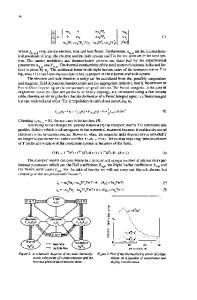Relationship between scratch hardness and yield strength of elastic perfectly plastic materials using finite element ana
- PDF / 638,657 Bytes
- 9 Pages / 612 x 792 pts (letter) Page_size
- 5 Downloads / 904 Views
With thin solid film usage expanding in numerous technologies, reliable measurements of material properties such as yield strength become important. However, for thin solid films the measurement of yield strength is not readily available, and an alternative method to obtain this property is to measure hardness and convert it to yield strength. Tabor suggested dividing hardness by ∼3 to obtain yield strength, which has been used extensively, despite its shortcomings. Since the pioneering work of Tabor, researchers have performed numerical and experimental studies to investigate the relationships between hardness, yield strength, and elastic modulus, using the indentation technique. In this study, finite element analysis was performed to simulate the nanoscratch technique. Specifically, the nanoscratch finite element analysis was used to validate a previously developed analytical scratch hardness model. A full-factorial design-of-experiments was performed to determine the significant variables for the ratio of calculated scratch hardness to yield strength and a simple analytical prediction model for the ratio of hardness to yield strength was proposed.
I. INTRODUCTION
Mechanical properties of materials, such as yield strength (Y), are typically measured by uniaxially loading a specimen either in tension or compression and measuring the load (stress) and displacement (strain) characteristics. Such testing methods cannot be readily used to measure properties when the material to be tested is very small (such as in microelectromechanical systems and magnetic storage recording devices) or the material is nonuniform and only a localized area needs to be tested. Unlike yield strength, hardness is not a fundamental material property; however, techniques for measuring hardness have been well developed especially at the micronano scales, and such measurements can be reliably performed on a variety of materials, including thin solid films. Specifically, the nanoindentation technique has been widely used to measure mechanical properties, such as hardness (H) and elastic modulus (E) of bulk materials and thin solid films down to few nanometers thick. The most widely used nanoindentation method is from Oliver and Pharr,1 where they proposed a technique to directly obtain hardness and reduced modulus values from na-
a)
Currently with Seagate Technology LLC. Address all correspondence to this author. e-mail: [email protected] DOI: 10.1557/JMR.2008.0279 b)
J. Mater. Res., Vol. 23, No. 8, Aug 2008
http://journals.cambridge.org
Downloaded: 06 Feb 2015
noindentation experiments. Subsequently Yu et al.2 developed a high-resolution load–displacement transducer, and Lee et al.3 have used this transducer to perform detailed subnanometer contact depth nanoindentation experiments on magnetic storage multilayered media. Note that the nanoindentation technique has also been successfully used to measure other mechanical properties, e.g., fracture toughness.4 In addition to measuring hardness with indentation, scratch hardness could also b
Data Loading...











